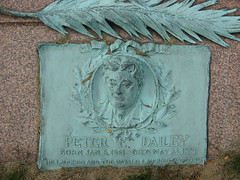On the East River at 12th Street, where today we find a promenade, there used to be piers where steamships would dock. It was there that a mischievous kid from the East Village hung out and took in the colorful banter of the minstrels and stevedores. From them, Peter F. Dailey learned all the twists that make this life funny.
They became part of his style, and by the 1890s Pete Dailey was a music hall sensation like none before. He practically invented improvisational comedy, using miscues and accidents to pull unscripted gags. For instance, one night the lights went out in the crowded theater. The audience spooked. But Mr. Dailey averted a panic by appearing onstage with a brakeman’s lantern as if it were a train wreck.
During another performance, in a kitchen scene, a heavy and gaudy necklace fell from the throat of his leading lady. He didn’t miss a beat, but calmly arose, took up the coal scoop and shoveled it into the icebox. It was, of course, the way he did it, complete with body language, that made him a star.
No one was safe from his anarchic style, not even on opening night. At one premier, another member of the cast, who was bald, had just made his entrance when Mr. Dailey, who had a bushy head of hair, upstaged him by shouting, “Why, here’s Charley, half-naked!”
He had a reputation as a tippler. No director could get him to a morning rehearsal, and he was late for everything else, except the performance. His frustrated stage manager once sent the entire cast out to look for him. Invariably, his excuse was comedy incarnate. On April Fools’ Day he came especially late, and said that he thought the scheduled time was a prank.
He was always “on,” as they say, and even joshed the police when arrested for disorderly conduct. “Come to the station!” one cop demanded. Mr. Dailey then suggested that they both take a cab, and he “jollied” the poor officer all the way there. On arrival, as you can imagine, he characteristically brought down the house.
Whether caught out in drunken brawls, or smashing the windows of the home of a prominent actress, the public forgave and adored him. He played all the major houses between here and Chicago, which is where, on May 23, 1908, he played his last. It was a performance he refused to cancel, despite a fever of 104. After the show he took to his bed, and he bantered and joked right up to the end. At age 47, he was dead of pneumonia.
Hundreds attended his funeral. One of his pall-bearers was none other than “Mr. Broadway” himself, George M. Cohan. On his grave marker at Green-Wood his epitaph reads: “He laughed, and the world laughed with him” – not a lament, really, but the key to his comedic style.





